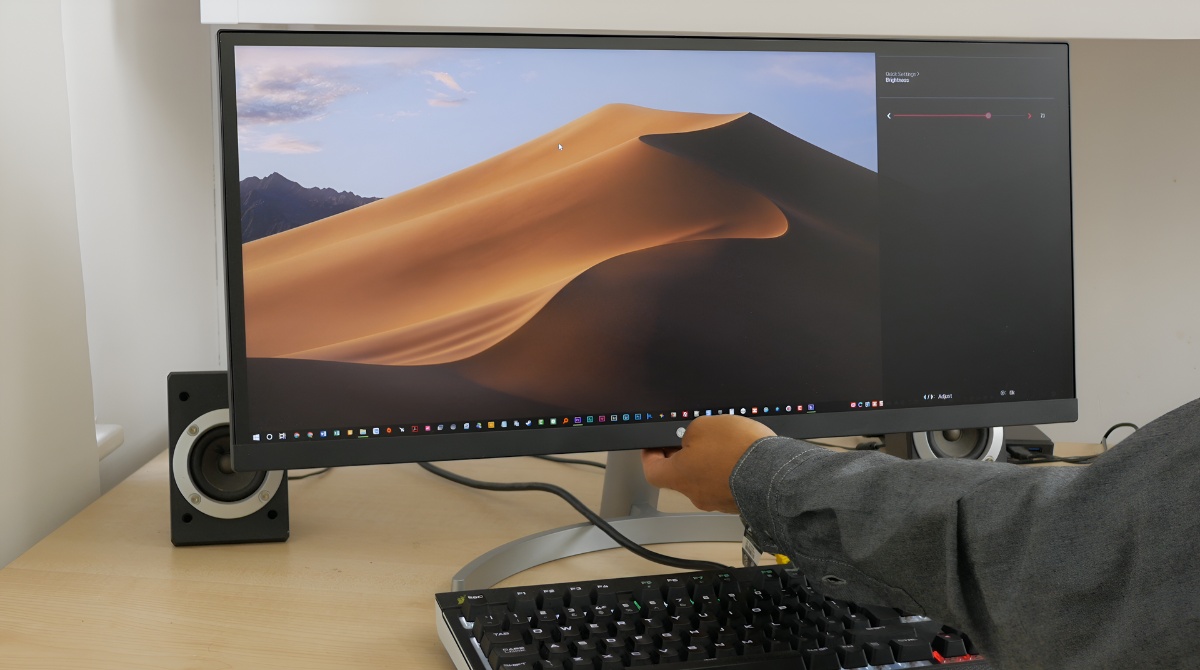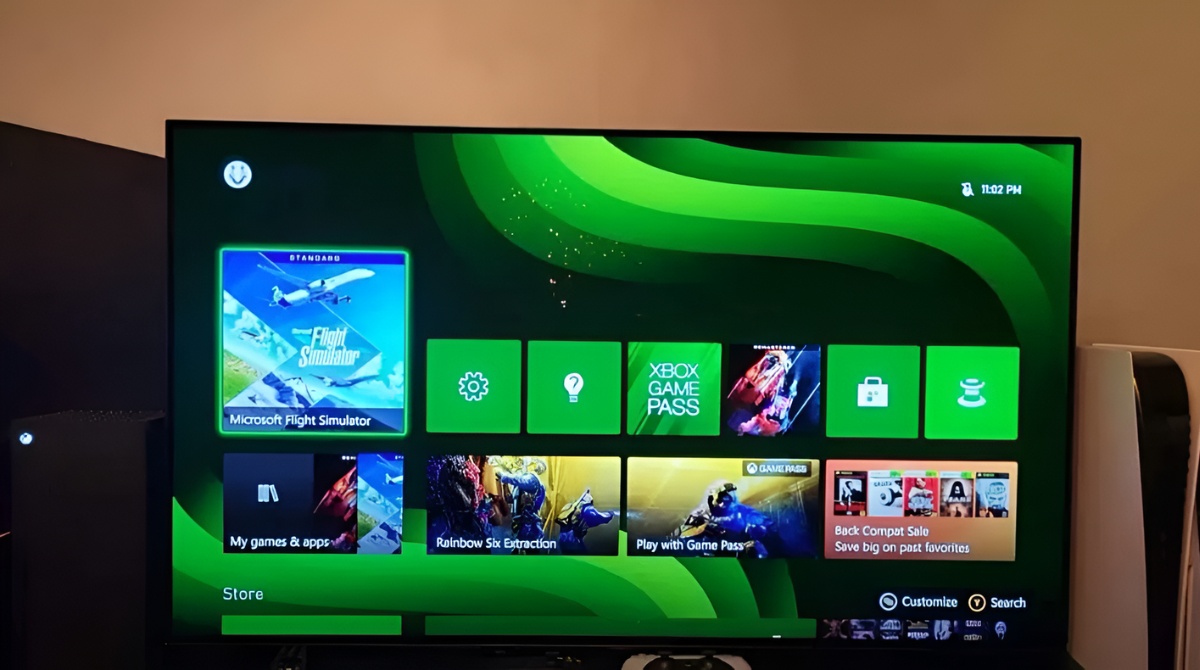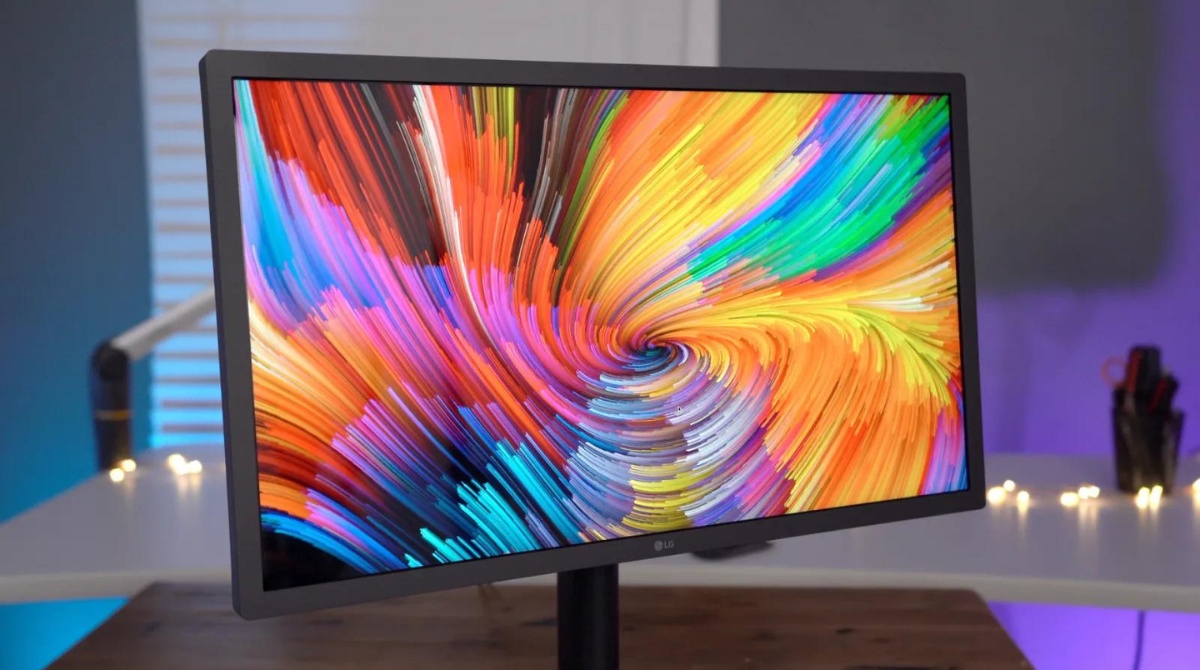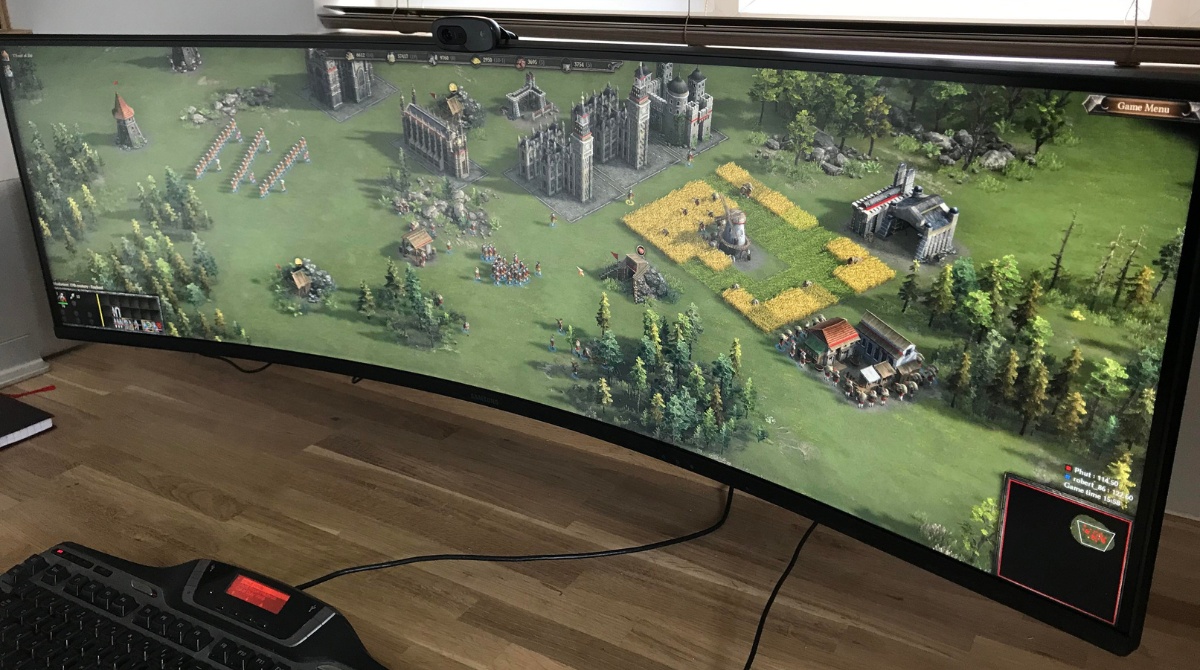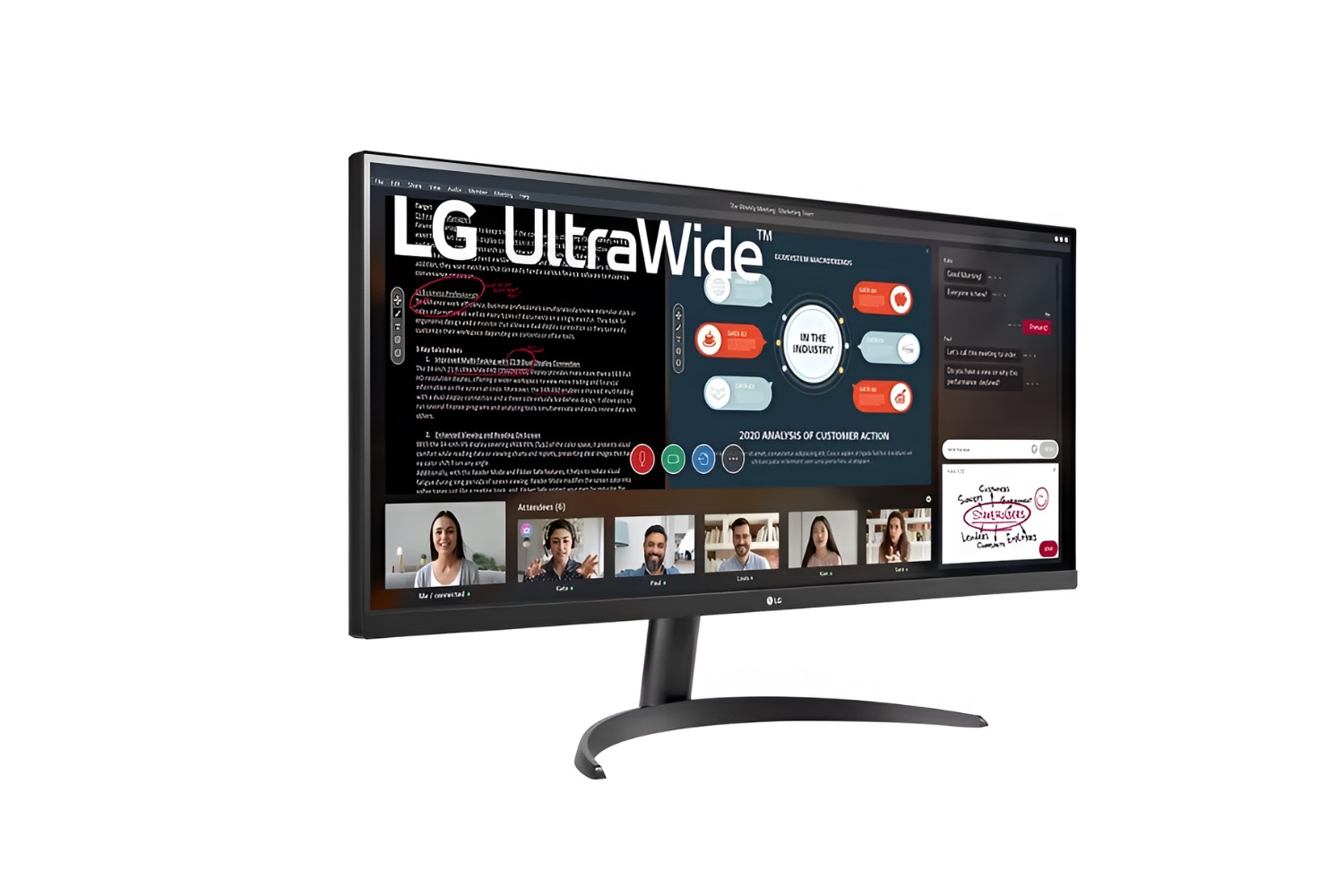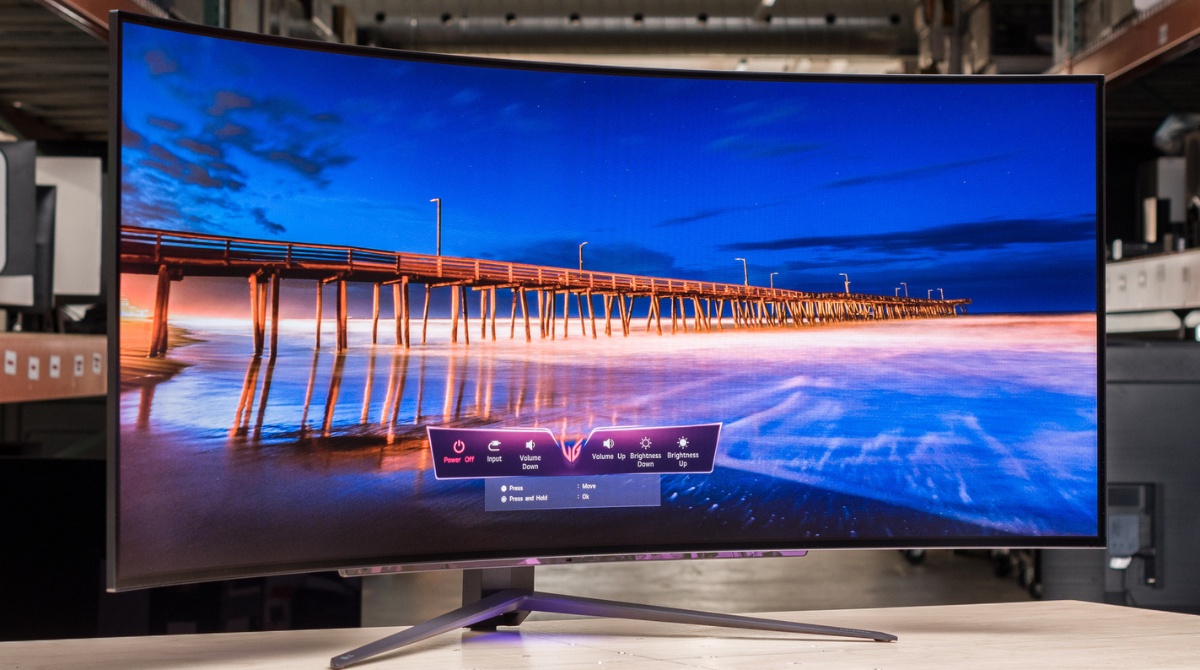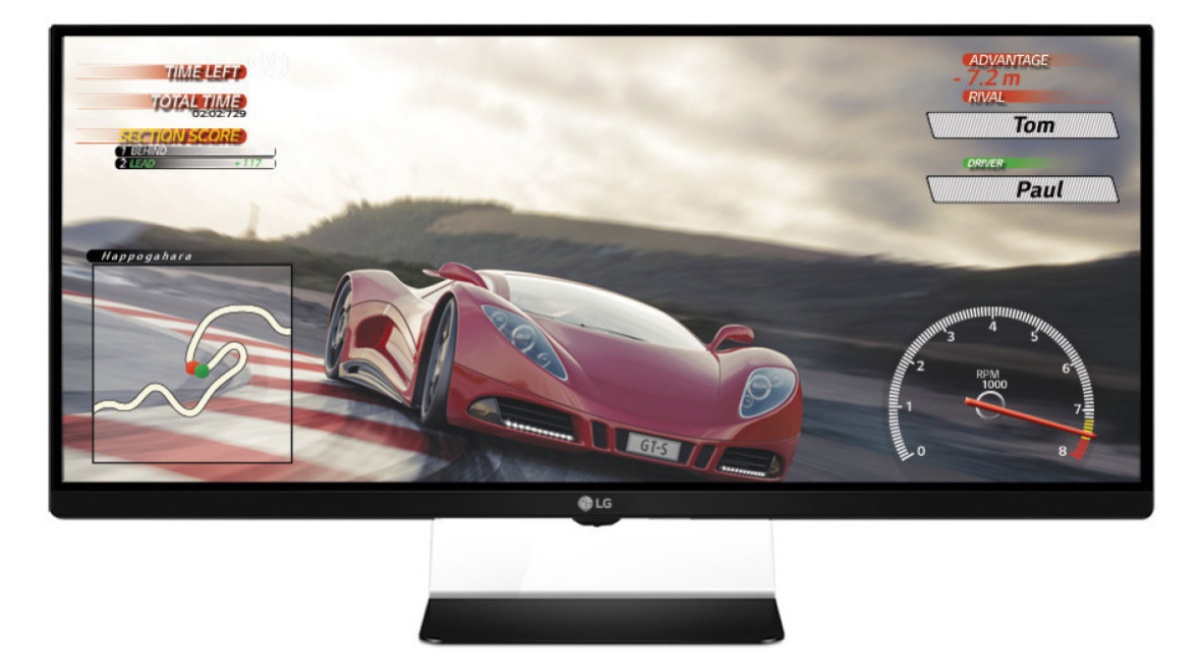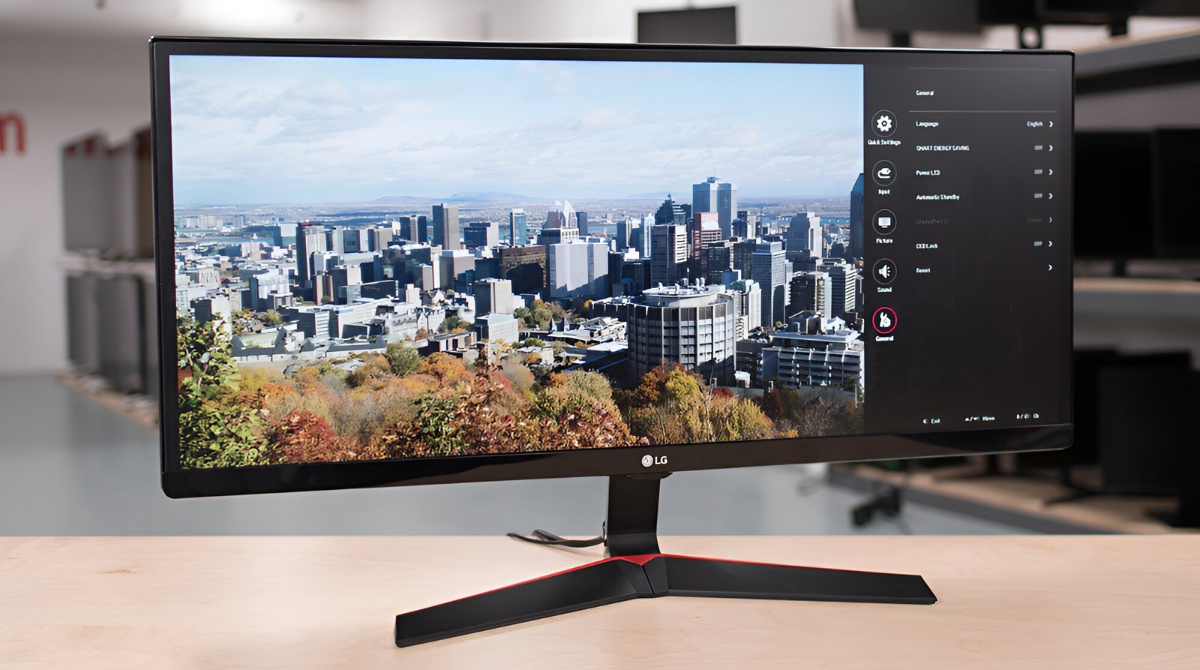Introduction
Welcome to the world of LG Ultrawide monitors! These cutting-edge displays offer a wide range of features and settings that allow you to customize your viewing experience according to your preferences. Whether you’re a gamer, designer, or simply someone who appreciates a crystal-clear and immersive visual experience, knowing how to change the settings on your LG Ultrawide monitor is essential.
With the ability to adjust brightness, contrast, color settings, screen resolution, and so much more, you have the power to optimize your monitor’s performance and tailor it to your specific needs. In this guide, we will walk you through the step-by-step process of changing the settings on your LG Ultrawide monitor, ensuring that you get the best out of your display.
Before we dive into the details, it’s important to note that the steps provided in this guide may vary slightly depending on the exact model of your LG Ultrawide monitor. However, the general concepts and functionalities remain the same across the range of LG Ultrawide displays.
So, let’s get started and unlock the full potential of your LG Ultrawide monitor by learning how to navigate and adjust its settings!
Step 1: Accessing the Settings Menu
The first step in changing the settings on your LG Ultrawide monitor is to access the settings menu. To do this, you will need to locate the control buttons or joystick on the bottom or rear of your monitor. These buttons are usually labeled with icons or symbols.
Once you have found the control buttons, press the menu button or the button with the settings icon. This will bring up the settings menu on the screen.
On some LG Ultrawide monitors, the settings menu may be accessed by pressing a specific combination of buttons or using a dedicated remote control. Refer to your monitor’s user manual for specific instructions if you’re unsure how to access the settings menu.
After accessing the settings menu, you will see a variety of options and submenus that allow you to customize your monitor’s settings. The control buttons or joystick can be used to navigate through the menu and select the desired options.
It’s worth mentioning that some LG Ultrawide monitors also offer the convenience of an on-screen display (OSD) that allows you to access and adjust settings directly from your computer’s desktop. This feature can be particularly useful if you prefer making adjustments using your mouse and keyboard rather than the control buttons on the monitor.
Now that we’ve covered the basics of accessing the settings menu let’s move on to the next step, where we’ll explore how to adjust the brightness and contrast of your LG Ultrawide monitor.
Step 2: Adjusting the Brightness and Contrast
Once you have accessed the settings menu on your LG Ultrawide monitor, you can begin adjusting the brightness and contrast to achieve the optimal image quality. These settings are essential for enhancing the clarity and richness of the displayed content.
To adjust the brightness and contrast, navigate to the “Picture” or “Display” submenu in the settings menu. Within this submenu, you will find options to modify the brightness, contrast, and other related settings.
Using the control buttons or joystick, increase or decrease the brightness and contrast levels until you achieve the desired visual effect. Keep in mind that the ideal settings may vary depending on the lighting conditions in your environment and your personal preference.
As you make adjustments, it’s a good idea to refer to test images or reference materials to ensure accurate calibration. You can find various online resources that provide test images specifically designed for monitor calibration.
Additionally, some LG Ultrawide monitors offer advanced features like dynamic contrast ratio, which automatically adjusts the contrast based on the content being displayed. If your monitor has this feature, you can enable or disable it in the settings menu.
Once you have fine-tuned the brightness and contrast settings to your liking, take a moment to evaluate the changes. Pay attention to details such as text clarity, color accuracy, and overall visual comfort.
Now that you have mastered the art of adjusting brightness and contrast, it’s time to move on to the next step and explore how to customize color settings on your LG Ultrawide monitor.
Step 3: Customizing Color Settings
Customizing the color settings of your LG Ultrawide monitor allows you to achieve accurate and vibrant colors that suit your personal preferences. With a range of options available in the settings menu, you have the flexibility to fine-tune the color output to your liking.
To access the color settings, navigate to the “Color” or “Color Settings” submenu in the settings menu of your LG Ultrawide monitor. Within this submenu, you will find various options such as color temperature, color gamut, and individual color adjustments.
One of the essential color settings is color temperature. This setting determines the overall warmth or coolness of the displayed colors. You can choose between preset options such as Cool, Normal, or Warm, or manually adjust the color temperature according to your preference.
Another important setting is the color gamut, which defines the range of colors that the monitor can display. Most LG Ultrawide monitors provide options like sRGB or Adobe RGB, which are commonly used color spaces. Select the color gamut that matches your intended use, such as photo editing or gaming.
Many LG Ultrawide monitors also offer individual color adjustment options, allowing you to fine-tune the red, green, and blue color channels independently. By modifying these color channels, you can achieve precise color reproduction based on your visual preferences.
As you make color adjustments, it’s essential to refer to reference materials or test images with known color values to ensure accurate calibration. This will help you achieve color accuracy and consistency across different devices and applications.
After customizing the color settings, take a moment to evaluate the changes by viewing various types of content, such as images, videos, and documents. Ensure that the colors appear vibrant, accurate, and pleasing to your eye.
With the color settings now personalized to your liking, let’s move on to the next step and explore how to change the screen resolution on your LG Ultrawide monitor.
Step 4: Changing Screen Resolution
Adjusting the screen resolution on your LG Ultrawide monitor allows you to optimize the display for different types of content and applications. By changing the resolution, you can modify the number of pixels displayed on the screen, affecting the clarity and sharpness of the visuals.
To change the screen resolution, navigate to the “Display” or “Screen” submenu in the settings menu of your LG Ultrawide monitor. Within this submenu, you will find the option to adjust the screen resolution.
Clicking on the screen resolution option will present you with a list of available resolution settings. The options may include various resolutions, such as 1920×1080 (Full HD), 2560×1440 (Quad HD), or 3840×2160 (4K Ultra HD). Choose the resolution that best suits your needs.
Keep in mind that selecting a higher resolution will provide more screen real estate, allowing you to fit more content on the screen. However, it may also make text and icons smaller, requiring you to adjust the scaling settings in your operating system for optimal readability.
On the other hand, choosing a lower resolution will result in larger text and icons, making them easier to read but sacrificing screen real estate. This option can be useful for those with visual impairments or for specific tasks that require larger elements.
It’s important to note that not all resolutions are supported by every monitor. If you select a resolution that is not supported, the screen may appear stretched or distorted. In such cases, choose a different resolution that is compatible with your LG Ultrawide monitor.
Once you have selected the desired screen resolution, the changes will take effect immediately. Take a moment to assess the new resolution and ensure that the visuals appear clear and sharp.
With the screen resolution now adjusted, let’s move on to the next step and explore how to configure the aspect ratio of your LG Ultrawide monitor.
Step 5: Configuring Aspect Ratio
Configuring the aspect ratio on your LG Ultrawide monitor allows you to control how the content is displayed on the screen. The aspect ratio determines the proportion of width to height, affecting the overall visual composition of the displayed image.
To configure the aspect ratio, navigate to the “Display” or “Screen” submenu in the settings menu of your LG Ultrawide monitor. Within this submenu, you will find the option to adjust the aspect ratio.
Typically, you will have options such as 16:9, 4:3, or 21:9 (the native aspect ratio of most LG Ultrawide monitors). Select the aspect ratio that best suits your preference or matches the content you are viewing.
The 16:9 aspect ratio is commonly used for watching movies and playing modern video games, as it provides a wide cinematic view. The 4:3 aspect ratio, on the other hand, is more suited for older games or certain professional applications.
For LG Ultrawide monitors with a 21:9 native aspect ratio, choosing this option will display the content in its original format. This aspect ratio is particularly ideal for multitasking and immersive gaming experiences.
It’s worth mentioning that some LG Ultrawide monitors offer additional aspect ratio options, such as 1:1 or custom aspect ratios. The 1:1 option will display the content in a square format, while the custom aspect ratio allows you to manually adjust the width and height proportions based on your preferences.
After selecting the desired aspect ratio, the changes will take effect immediately. Take a moment to review the new aspect ratio and ensure that the content is displayed in the desired format.
Now that you have configured the aspect ratio, let’s move on to the next step and explore how to manage On-Screen Display (OSD) settings on your LG Ultrawide monitor.
Step 6: Managing On-Screen Display (OSD) Settings
The On-Screen Display (OSD) settings on your LG Ultrawide monitor allow you to customize the appearance and functionality of the menu that appears on the screen. This includes adjusting options such as language settings, transparency, timeout duration, and more.
To access the OSD settings, navigate to the “Settings” or “OSD” submenu in the settings menu of your LG Ultrawide monitor. Within this submenu, you will find various options to manage the OSD settings.
One of the key settings you can adjust is the language. Select the language of your choice from the available options to ensure that the OSD menu is displayed in a language you are comfortable with.
Another important setting is the transparency of the OSD menu. You can adjust the level of transparency to your preference, allowing you to see through the menu while making adjustments or maintaining a more opaque appearance for better visibility.
Most LG Ultrawide monitors also offer the option to set the timeout duration for the OSD menu. This determines how long the menu will remain on the screen before it automatically disappears to avoid interfering with your viewing experience.
In addition to these basic settings, you may find advanced options such as gesture control, where you can perform specific gestures to navigate through the OSD menu. This feature is usually available on touch-enabled LG Ultrawide monitors.
Once you have made the desired changes to the OSD settings, navigate through the menu to familiarize yourself with the new appearance and functionality. Ensure that the settings meet your requirements and provide a seamless and intuitive user experience.
With the OSD settings now managed, let’s move on to the next step and explore how to enable or disable gaming features on your LG Ultrawide monitor.
Step 7: Enabling or Disabling Gaming Features
LG Ultrawide monitors often come equipped with gaming-specific features and technologies that enhance the gaming experience. These features can include options such as Game Mode, FreeSync, Black Stabilizer, and more. In this step, we will explore how to enable or disable these gaming features on your LG Ultrawide monitor.
To access the gaming features settings, navigate to the “Gaming” or “Game Mode” submenu in the settings menu of your LG Ultrawide monitor. Within this submenu, you will find various options related to gaming enhancements.
One of the prominent gaming features available on many LG Ultrawide monitors is Game Mode. Enabling Game Mode optimizes the monitor settings for gaming, such as reducing input lag and enhancing the response time, resulting in a smoother and more immersive gaming experience.
Additionally, if your LG Ultrawide monitor supports AMD FreeSync technology, you can enable it to synchronize the refresh rate of the monitor with the graphics card output, reducing screen tearing and stuttering during gameplay.
Another useful gaming feature is Black Stabilizer, which improves visibility in dark scenes by dynamically brightening dark areas of the image. Enabling this feature can give you a competitive advantage in games that feature low-light environments or stealth gameplay.
Depending on the specific model of your LG Ultrawide monitor, you may find other gaming features such as Crosshair Overlay, which provides on-screen crosshairs for enhanced aiming accuracy, or Game Color, which boosts the vibrancy and saturation of colors for a more immersive visual experience.
Experiment with these gaming features, enabling or disabling them according to your preferences and the requirements of the games you play. Take the time to test each feature while playing games and assess how they impact your gaming experience.
With the gaming features now enabled or disabled to suit your needs, let’s move on to the next step and explore how to fine-tune the Picture Mode on your LG Ultrawide monitor.
Step 8: Fine-tuning Picture Mode
The Picture Mode settings on your LG Ultrawide monitor allow you to further refine the visual quality and color reproduction based on different scenarios or content types. With various preset modes and customizable options, you can optimize the picture settings to suit your specific needs.
To access the Picture Mode settings, navigate to the “Picture” or “Display” submenu in the settings menu of your LG Ultrawide monitor. Within this submenu, you will find options related to Picture Mode and its associated settings.
LG Ultrawide monitors typically offer a range of preset Picture Modes, such as Standard, Vivid, Cinema, Game, and more. Each mode is designed to enhance the visuals for specific use cases, such as general viewing, gaming, or movie watching.
Experiment with the different preset Picture Modes to find the one that best suits your preferences and the type of content you are viewing. Each mode may have different settings for brightness, contrast, sharpness, and color saturation that are optimized for specific scenarios.
In addition to the preset modes, many LG Ultrawide monitors also provide the flexibility to customize individual picture settings. These options can include adjusting the brightness, contrast, color temperature, and sharpness to further fine-tune the picture quality according to your specific preferences.
While adjusting the picture settings, it can be helpful to reference visual content that you are familiar with, such as photos, videos, or games, to assess the impact of the changes you make. This will allow you to find the right balance of settings that deliver the desired visual experience.
After fine-tuning the Picture Mode settings, take a moment to review the changes and ensure that the visual quality meets your expectations. Make adjustments as necessary until you are satisfied with the overall picture quality and color reproduction.
With the Picture Mode now fine-tuned to your liking, let’s move on to the next step and explore how to control the Black Stabilizer on your LG Ultrawide monitor.
Step 9: Controlling Black Stabilizer
The Black Stabilizer setting on your LG Ultrawide monitor allows you to enhance the visibility and details in darker areas of the image. This feature is particularly useful for gaming or watching content that features low-light scenes or shadows.
To control the Black Stabilizer, navigate to the “Picture” or “Display” submenu in the settings menu of your LG Ultrawide monitor. Within this submenu, you will find the option to adjust the Black Stabilizer setting.
Increasing the Black Stabilizer value will brighten the dark areas of the image, revealing hidden details and enhancing visibility. This can be beneficial in games where spotting enemies hiding in the shadows is crucial or when watching movies with dimly lit scenes.
However, it’s important to use the Black Stabilizer feature in moderation. Overdoing it may result in an image that appears washed out or lacking depth, as the dark areas may lose their natural contrast. Experiment with different settings to find the balance that suits your preference.
When adjusting the Black Stabilizer, it’s helpful to reference content with varying lighting conditions, such as games, movies, or images, to assess the impact of the changes. This will allow you to determine the level of Black Stabilizer that offers the best visibility without compromising the overall image quality.
Remember that the ideal Black Stabilizer setting may vary depending on the specific content being displayed and your personal preferences. Take the time to find the right balance that enhances visibility without sacrificing the integrity of the original image.
With the Black Stabilizer now under control, let’s move on to the next step and explore how to adjust the Response Time of your LG Ultrawide monitor.
Step 10: Adjusting Response Time
The response time setting on your LG Ultrawide monitor determines how quickly the monitor updates the displayed image. It is especially relevant for fast-paced gaming and can affect the smoothness and clarity of motion in gaming and other high-action content.
To adjust the response time, navigate to the “Settings” or “Display” submenu in the settings menu of your LG Ultrawide monitor. Within this submenu, you will find options related to response time or motion blur reduction.
LG Ultrawide monitors often provide different response time settings, such as Fast, Normal, or Off. A lower response time value typically leads to a faster monitor refresh rate, reducing motion blur and enhancing the clarity of fast-moving objects on the screen.
Adjusting the response time depends on personal preference and the type of content you are viewing or playing. If you prioritize smooth and fluid motion, a lower response time setting is recommended. However, keep in mind that very low response time settings may introduce inverse ghosting artifacts or other visual artifacts.
For gaming, where responsiveness is crucial, it is often recommended to select the Fast or Gaming mode for optimal performance. This will minimize motion blur and provide sharper visuals during fast-paced gameplay.
As you adjust the response time setting, it can be helpful to reference fast-moving content, such as games with rapid camera movements or action-packed scenes in movies. This will allow you to gauge the impact of the changes and find the response time setting that provides the best balance of visual clarity and responsiveness.
Remember that response time preferences can vary among individuals, so it’s important to find the setting that feels most comfortable and visually pleasing to you. Take the time to try different response time settings and evaluate the impact on motion clarity before settling on the optimal value.
With the response time adjusted, let’s move on to the next step and explore how to calibrate Motion Blur Reduction on your LG Ultrawide monitor.
Step 11: Calibrating Motion Blur Reduction
Calibrating the Motion Blur Reduction feature on your LG Ultrawide monitor can significantly enhance the clarity and smoothness of fast-moving content, reducing motion blur and ensuring a more immersive visual experience, especially during gaming or action-packed video playback.
To calibrate Motion Blur Reduction, navigate to the “Settings” or “Display” submenu in the settings menu of your LG Ultrawide monitor. Within this submenu, you will find options related to Motion Blur Reduction.
LG Ultrawide monitors typically offer different levels or modes of Motion Blur Reduction, such as Low, Medium, or High. Each level indicates the degree to which the monitor reduces motion blur and enhances clarity during fast-paced scenes.
To find the optimal Motion Blur Reduction setting, it’s recommended to test the different levels while viewing content that involves rapid motion, such as fast-scrolling text or fast-paced games. Observe the level of motion blur reduction achieved at each setting and select the one that provides the best balance of clarity and smoothness for your preferences.
Keep in mind that enabling Motion Blur Reduction may introduce a slight trade-off by dimming the overall brightness of the display. This is because the technology utilizes backlight strobing techniques to reduce motion blur.
Additionally, some LG Ultrawide monitors may offer advanced options for managing Motion Blur Reduction, such as customizable strobe lengths, black frame insertion, or synchronization with frame rates. These settings allow you to fine-tune the motion handling capabilities to achieve the desired balance of motion clarity and brightness.
When calibrating Motion Blur Reduction, it’s essential to consider both personal preference and the specific content you typically consume. Spend some time experimenting with different settings and observing the impact on motion clarity to find the configuration that best suits your needs.
With Motion Blur Reduction now calibrated on your LG Ultrawide monitor, let’s proceed to the next step and explore how to set up a multi-screen display, if applicable.
Step 12: Setting Up Multi-Screen Display
If your LG Ultrawide monitor supports a multi-screen display, you can expand your workspace and enhance productivity by connecting multiple monitors together. This allows you to work on multiple applications simultaneously or extend the desktop across multiple screens.
To set up a multi-screen display, you will need to connect additional monitors to your LG Ultrawide monitor. The exact method of connection may vary depending on the available ports on your LG Ultrawide monitor and the additional monitors you are using.
Most LG Ultrawide monitors have multiple connectivity options, such as HDMI, DisplayPort, or USB-C. Ensure that your additional monitors have compatible ports that can be connected to your LG Ultrawide monitor.
Once you have physically connected the additional monitors, you may need to configure the display settings. Navigate to the “Display” or “Screen” submenu in the settings menu of your LG Ultrawide monitor and look for options related to multi-screen or display settings.
Depending on your preference and requirements, you can choose different display configurations, such as duplicating the screen across all monitors or extending the desktop to provide additional workspace. Adjust the screen orientation and positioning as needed to create a seamless and ergonomic multi-screen setup.
If needed, you can also set a primary monitor, which will be the main display for your desktop icons and taskbar. This can be useful for ensuring that the primary monitor remains the central point of focus in your multi-screen setup.
Once the multi-screen display is set up, take a moment to test the configuration by moving applications and windows across the different screens. Ensure that the content appears correctly and that the mouse cursor flows smoothly between the monitors.
Remember that the overall performance and functionality of a multi-screen setup can depend on the capabilities of your graphics card and the specific software or operating system you are using. Consult the user manual or online resources for more information on optimizing your multi-screen display.
With your multi-screen display now set up, let’s move on to the final step and explore how to reset your LG Ultrawide monitor to factory settings.
Step 13: Resetting to Factory Settings
If you encounter issues with your LG Ultrawide monitor or simply want to revert all settings back to their original state, you can perform a factory reset. This process will restore the monitor’s settings to the default configurations as when you first purchased it.
To initiate a factory reset, navigate to the “Settings” or “Reset” submenu in the settings menu of your LG Ultrawide monitor. Look for an option that allows you to perform a full reset or restore all settings to default.
Before proceeding with the factory reset, it is crucial to note that this action will erase all custom settings, including brightness, contrast, color adjustments, gaming features, and any other preferences you have set. It is advised to take note or capture screenshots of your preferred settings for future reference, as they will all be lost during the reset process.
Once you are prepared, confirm the factory reset command. The monitor will then undergo the reset process, which may take a few moments. Do not unplug or power off the monitor during this time.
After the factory reset is completed, the monitor will restart, and you will be greeted with the default settings and configurations. You can now begin reconfiguring the monitor to your liking, adjusting the various settings and features to suit your preferences and requirements.
In some instances, a factory reset may resolve any technical issues or software glitches you may have encountered on your LG Ultrawide monitor. It provides a fresh start and eliminates any potential conflicts or errors that may have arisen from custom settings or changes made over time.
Remember that a factory reset should be used as a last resort or troubleshooting step. If you are experiencing persistent issues with your LG Ultrawide monitor, it is advisable to consult the user manual or contact LG customer support for further assistance and guidance.
With the factory reset now completed, you have successfully learned how to navigate and adjust the various settings on your LG Ultrawide monitor. Enjoy the optimized visual experience and tailor it to your specific needs and preferences!
Conclusion
Congratulations! You have now mastered the art of changing settings on your LG Ultrawide monitor. By accessing the settings menu, you can unlock a world of customization options to optimize your viewing experience.
We began by learning how to access the settings menu and navigate through its various submenus. Then, we explored important settings such as adjusting brightness and contrast, customizing color settings, changing screen resolution, configuring aspect ratio, managing On-Screen Display (OSD) settings, and enabling or disabling gaming features.
We also delved into fine-tuning the Picture Mode, controlling Black Stabilizer, adjusting response time, calibrating Motion Blur Reduction, setting up a multi-screen display (if applicable), and resetting to factory settings.
Remember, the specific steps and options may vary slightly depending on your LG Ultrawide monitor model. Always refer to your monitor’s user manual for precise instructions relating to your particular device.
By understanding and utilizing these settings, you can now tailor your LG Ultrawide monitor to your specific needs, whether you’re a gamer seeking optimal performance, a designer craving color accuracy, or simply someone looking to enhance their visual experience.
Experiment with the settings, trust your visual judgement, and take the time to adjust and fine-tune to your personal preferences. With each adjustment, you will unlock the full potential of your LG Ultrawide monitor, immersing yourself in a world of stunning visuals and unparalleled clarity.
So go ahead, explore the settings, and let your LG Ultrawide monitor transform your viewing experience to new heights. Enjoy the vibrant colors, sharp details, and smooth motion that will bring all your content to life!







